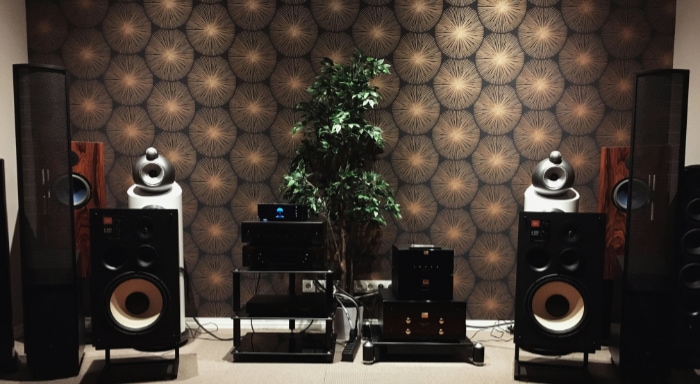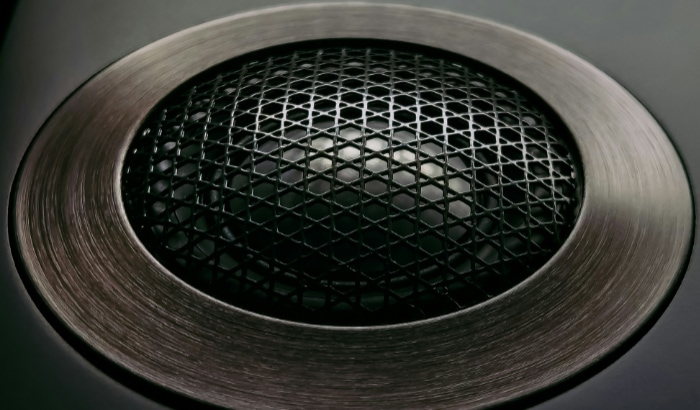5.1.2 vs. 7.1: How to Choose the Right Surround Sound

Elevating your home entertainment setup to a surround sound system is a game-changer, offering an immersive audio experience that can transport you straight into the heart of movies, music, and games. With options like 5.1.2 and 7.1 configurations on the table, understanding which system aligns with your auditory aspirations and room specifications is key.
The 5.1.2 Surround Sound Setup
Choosing the right surround sound setup transforms how we experience movies, music, and games. Among various configurations, the 5.1.2 system stands out for its ability to deliver an immersive audio experience with added depth and dimensionality.
This setup involves five speakers, one subwoofer, and two overhead or upward-firing speakers to create a three-dimensional sound space.
Components of a 5.1.2 System
A 5.1.2 surround sound system includes seven primary components. The ‘5’ refers to five main speakers: two front speakers, one center speaker, and two surround speakers.
The ‘.1’ indicates a single subwoofer, responsible for low-frequency sounds or bass. Lastly, the ‘.2’ represents two overhead or upward-firing speakers, designed to add a vertical dimension to the sound, giving the impression of audio coming from above.
Advantages of 5.1.2 Setup
The primary benefit of the 5.1.2 setup is its enhanced audio depth and dimensionality. This system excels in delivering precise, clear, and immersive sound that not only surrounds the listener but also provides vertical sound effects.
It’s particularly effective when playing content mastered in Dolby Atmos, which uses these overhead channels to place sounds in three-dimensional space. This setup can significantly enhance the viewing experience of movies and games, making action scenes more thrilling and immersive.
Suitable Environments and Content
While the 5.1.2 system offers a remarkable audio experience, it shines best in environments where it can be properly set up and calibrated. Medium-sized rooms are ideal, allowing for optimal speaker placement and sound propagation.
Additionally, this setup is best paired with content that supports Dolby Atmos or other surround sound technologies capable of utilizing overhead sound channels. Whether you’re watching the latest blockbuster movies or playing immersive video games, the 5.1.2 system can elevate your audio experience to new heights.
The 7.1 Surround Sound Setup
For those seeking an advanced audio setup that offers an even more encompassing sound experience, the 7.1 surround sound system presents a compelling option. This configuration builds on the traditional 5.1 setup by adding two additional speakers, enhancing the audio field and providing listeners with an even more detailed and immersive sound environment.
Structure of a 7.1 System
A 7.1 surround sound system consists of eight key components. The ‘7’ signifies seven main speakers: a center speaker, two front speakers, two surround speakers, and two additional rear speakers.
The ‘.1’ in 7.1 denotes a single subwoofer dedicated to reproducing low-frequency effects and bass, rounding out the audio experience. This setup is designed to envelop the listener with sound, effectively placing them in the center of the action, whether that’s in a movie scene or in the heart of a video game.
Benefits of the 7.1 Setup
The 7.1 surround sound system excels in providing a broad and immersive audio landscape. The inclusion of rear speakers adds depth to the sound field, offering enhanced directional audio cues.
This makes the 7.1 system particularly suitable for large room setups where the sound can fully propagate, ensuring that audio details are not lost. It’s a favored choice for home theaters and gaming environments where capturing the nuances of sound can greatly enhance the overall experience.
Ideal Uses and Environments
The 7.1 surround sound system is most effective in spaces where its expanded audio capabilities can be fully appreciated. Large rooms or dedicated home theaters are ideal, allowing for the proper placement of speakers and preventing sound from being confined.
Additionally, this system thrives with content that supports 7.1 audio tracks, commonly found in many modern movies and video games. By fully utilizing the additional rear speakers, the 7.1 setup offers a more immersive and engaging listening experience.
Comparing 5.1.2 and 7.1 Systems

Choosing the right surround sound setup is key to maximizing your audio-visual experience at home. The 5.1.2 and 7.1 systems each offer unique advantages, catering to different preferences and room configurations.
Spatial Audio Capabilities
The 5.1.2 system introduces listeners to the dimension of height in audio, thanks to its two overhead or upward-firing speakers. This setup excels in creating a three-dimensional sound space, making it ideal for content mastered in Dolby Atmos.
On the other hand, the 7.1 system expands the horizontal sound field by adding two rear speakers, enhancing the envelopment and directionality of sound without the vertical component.
Setup Requirements and Considerations
Setting up a 5.1.2 system requires careful consideration of ceiling or speaker height for the optimal utilization of its upward-firing speakers. It’s a great choice for rooms where installing in-ceiling speakers isn’t possible but where immersive, three-dimensional sound is desired.
Conversely, a 7.1 system, while easier to install since all speakers are at ear level, requires more space to properly distribute the additional rear speakers, making it better suited for larger rooms.
Content Compatibility
The choice between 5.1.2 and 7.1 may also depend on the type of content you consume. The 5.1.2 setup is specifically designed to leverage the benefits of Dolby Atmos and other formats that use overhead sound channels, offering a more immersive experience for movies and games that support these technologies.
The 7.1 system, while not utilizing overhead sound, provides a rich and detailed soundscape for a wide range of content, including standard surround sound formats.
Making Your Decision
Deciding between a 5.1.2 and a 7.1 surround sound system boils down to your personal preferences, the physical characteristics of your listening environment, and the types of media you enjoy. If you’re looking for an immersive experience with movies and gaming, and your space can accommodate upward-firing or in-ceiling speakers, the 5.1.2 system might be the best fit.
However, if your preference leans towards an expansive sound field in a larger room without the complexity of installing overhead speakers, a 7.1 system could be more appropriate.
Installation and Equipment Considerations
When setting up a surround sound system, whether it’s a 5.1.2 or a 7.1 configuration, several critical factors come into play. The right selection and placement of equipment can significantly influence the overall sound quality and immersive experience.
Selecting Compatible Audio Equipment
The foundation of a high-quality surround sound system lies in the selection of compatible components. This includes a capable receiver that matches the audio format of your chosen setup and speakers that suit the size and acoustics of your room.
For a 5.1.2 system, ensure the receiver supports Dolby Atmos or DTS:X for handling overhead sound channels. For a 7.1 system, the receiver should be capable of distributing sound across a broader field without the need for overhead audio.
Speaker Placement for Optimal Sound Quality
Proper speaker placement is paramount in creating an enveloping audio experience. For a 5.1.2 setup, the front and surround speakers should be placed at ear level, while the overhead or upward-firing speakers need to be positioned to reflect sound off the ceiling accurately.
In a 7.1 system, the additional rear speakers should be placed behind the listening area to enhance depth and directionality of sound. The subwoofer’s placement is flexible but experimenting with different locations can help find the spot where bass sounds best.
Understanding Room Acoustics
Room acoustics play a significant role in sound propagation and can affect the audio quality of your surround sound system. Hard surfaces can cause sound reflections that may muddy audio clarity, while too many soft surfaces might absorb sound excessively, reducing its impact.
Consider using rugs, curtains, or acoustic panels to balance the acoustics of the room, ensuring a clear and dynamic audio reproduction.
Conclusion
Enhancing your home entertainment experience with a surround sound system requires thoughtful consideration of your space, preferences, and the content you enjoy. Both 5.1.2 and 7.1 configurations offer distinct advantages, from the vertical dimension of sound in 5.1.2 setups to the broad soundstage provided by 7.1 systems.
Equally important are the selection of compatible audio equipment, strategic speaker placement, and managing room acoustics to ensure the best sound quality. By weighing these factors, you can create an audio environment that brings out the best in movies, music, and games, making every listening moment more immersive and enjoyable.



